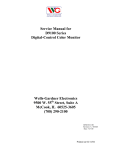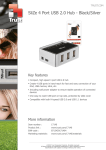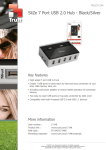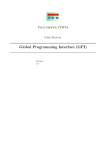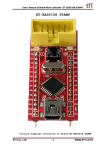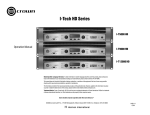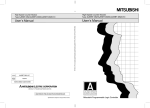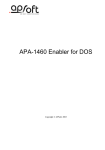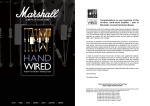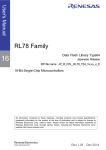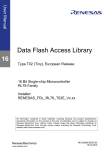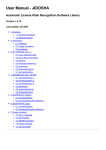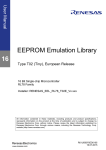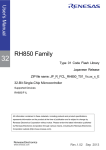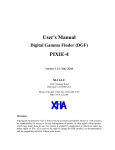Download Data Flash Access Library
Transcript
User Manual
Data Flash Access Library
Type T01, European Release
16
16 Bit Single-chip Microcontroller
78K0R/Fx3 Series
Installer: RENESAS_FDL_78K0R_T01E_Vx.xxx
All information contained in these materials, including products and product specifications,
represents information on the product at the time of publication and is subject to change by
Renesas Electronics Corp. without notice. Please review the latest information published by
Renesas Electronics Corp. through various means, including the Renesas Technology Corp.
website (http://www.renesas.com).
www.renesas.com
R01US0005ED0102
June 25, 2013
Notice
1.
2.
3.
4.
5.
6.
7.
All information included in this document is current as of the date this document is issued. Such information, however,
is subject to change without any prior notice. Before purchasing or using any Renesas Electronics products listed
herein, please confirm the latest product information with a Renesas Electronics sales office. Also, please pay regular
and careful attention to additional and different information to be disclosed by Renesas Electronics such as that
disclosed through our website.
Renesas Electronics does not assume any liability for infringement of patents, copyrights, or other intellectual property
rights of third parties by or arising from the use of Renesas Electronics products or technical information described in
this document. No license, express, implied or otherwise, is granted hereby under any patents, copyrights or other
intellectual property rights of Renesas Electronics or others.
You should not alter, modify, copy, or otherwise misappropriate any Renesas Electronics product, whether in whole or
in part.
Descriptions of circuits, software and other related information in this document are provided only to illustrate the
operation of semiconductor products and application examples. You are fully responsible for the incorporation of
these circuits, software, and information in the design of your equipment. Renesas Electronics assumes no
responsibility for any losses incurred by you or third parties arising from the use of these circuits, software, or
information.
When exporting the products or technology described in this document, you should comply with the applicable export
control laws and regulations and follow the procedures required by such laws and regulations. You should not use
Renesas Electronics products or the technology described in this document for any purpose relating to military
applications or use by the military, including but not limited to the development of weapons of mass destruction.
Renesas Electronics products and technology may not be used for or incorporated into any products or systems whose
manufacture, use, or sale is prohibited under any applicable domestic or foreign laws or regulations.
Renesas Electronics has used reasonable care in preparing the information included in this document, but Renesas
Electronics does not warrant that such information is error free. Renesas Electronics assumes no liability whatsoever
for any damages incurred by you resulting from errors in or omissions from the information included herein.
Renesas Electronics products are classified according to the following three quality grades: “Standard”, “High
Quality”, and “Specific”. The recommended applications for each Renesas Electronics product depends on the
product’s quality grade, as indicated below. You must check the quality grade of each Renesas Electronics product
before using it in a particular application. You may not use any Renesas Electronics product for any application
categorized as “Specific” without the prior written consent of Renesas Electronics. Further, you may not use any
Renesas Electronics product for any application for which it is not intended without the prior written consent of
Renesas Electronics. Renesas Electronics shall not be in any way liable for any damages or losses incurred by you or
third parties arising from the use of any Renesas Electronics product for an application categorized as “Specific” or for
which the product is not intended where you have failed to obtain the prior written consent of Renesas Electronics.
The quality grade of each Renesas Electronics product is “Standard” unless otherwise expressly specified in a Renesas
Electronics data sheets or data books, etc.
“Standard”:
8.
9.
10.
Computers; office equipment; communications equipment; test and measurement equipment; audio
and visual equipment; home electronic appliances; machine tools; personal electronic equipment; and
industrial robots.
“High Quality”: Transportation equipment (automobiles, trains, ships, etc.); traffic control systems; anti-disaster
systems; anti-crime systems; safety equipment; and medical equipment not specifically designed for
life support.
“Specific”:
Aircraft; aerospace equipment; submersible repeaters; nuclear reactor control systems; medical
equipment or systems for life support (e.g. artificial life support devices or systems), surgical
implantations, or healthcare intervention (e.g. excision, etc.), and any other applications or purposes
that pose a direct threat to human life.
You should use the Renesas Electronics products described in this document within the range specified by Renesas
Electronics, especially with respect to the maximum rating, operating supply voltage range, movement power voltage
range, heat radiation characteristics, installation and other product characteristics. Renesas Electronics shall have no
liability for malfunctions or damages arising out of the use of Renesas Electronics products beyond such specified
ranges.
Although Renesas Electronics endeavors to improve the quality and reliability of its products, semiconductor products
have specific characteristics such as the occurrence of failure at a certain rate and malfunctions under certain use
conditions. Further, Renesas Electronics products are not subject to radiation resistance design. Please be sure to
implement safety measures to guard them against the possibility of physical injury, and injury or damage caused by fire
in the event of the failure of a Renesas Electronics product, such as safety design for hardware and software including
but not limited to redundancy, fire control and malfunction prevention, appropriate treatment for aging degradation or
any other appropriate measures. Because the evaluation of microcomputer software alone is very difficult, please
evaluate the safety of the final products or system manufactured by you.
Please contact a Renesas Electronics sales office for details as to environmental matters such as the environmental
compatibility of each Renesas Electronics product. Please use Renesas Electronics products in compliance with all
R01US0005ED0102
User Manual
2
11.
12.
applicable laws and regulations that regulate the inclusion or use of controlled substances, including without limitation,
the EU RoHS Directive. Renesas Electronics assumes no liability for damages or losses occurring as a result of your
noncompliance with applicable laws and regulations.
This document may not be reproduced or duplicated, in any form, in whole or in part, without prior written consent of
Renesas Electronics.
Please contact a Renesas Electronics sales office if you have any questions regarding the information contained in this
document or Renesas Electronics products, or if you have any other inquiries.
(Note 1) “Renesas Electronics” as used in this document means Renesas Electronics Corporation and also includes its
majority-owned subsidiaries.
(Note 2) “Renesas Electronics product(s)” means any product developed or manufactured by or for Renesas Electronics.
R01US0005ED0102
User Manual
3
Table of Contents
Chapter 1
1.1
Introduction .........................................................................................................................6
Components of the EEPROM Emulation System ..................................................................... 7
1.1.1
Physical flash layer ............................................................................................................ 7
1.1.2
Flash access layer ............................................................................................................. 7
1.1.3
EEPROM access layer ...................................................................................................... 7
1.1.4
Application layer................................................................................................................. 7
1.2
Naming Conventions ................................................................................................................. 8
Chapter 2
2.1
Architecture .........................................................................................................................9
Data Flash fragmentation .......................................................................................................... 9
2.1.1
FDL pool ............................................................................................................................ 9
2.1.2
EEL pool .......................................................................................................................... 10
2.1.3
USER pool ....................................................................................................................... 10
2.2
Address virtualization .............................................................................................................. 11
2.3
Access right supervision ......................................................................................................... 12
2.4
Request-Response architecture ............................................................................................. 13
2.5
Background operation ............................................................................................................. 14
2.5.1
Background operation (Erase) ......................................................................................... 14
2.5.2
Background operation (write)........................................................................................... 15
2.5.3
Background operation (blank-check/verify) ..................................................................... 16
2.5.4
No background operation for read command .................................................................. 16
2.6
Suspension of block oriented commands (erase) ................................................................... 17
Chapter 3
User interface (API) ..........................................................................................................18
3.1
Run-time configuration ............................................................................................................ 18
3.2
Data types ............................................................................................................................... 19
3.2.1
Library specific simple type definitions ............................................................................ 19
3.2.2
Enumeration type “fal_command_t” ................................................................................ 19
3.2.3
Enumeration type “ fal_status_t” ...................................................................................... 20
3.2.4
Structured type “fal_request_t” ........................................................................................ 20
3.2.5
Structured type “fal_descriptor_t” .................................................................................... 21
3.3
Functions ................................................................................................................................. 23
3.3.1
Basic functional workflow ................................................................................................. 23
3.3.2
Interface functions ........................................................................................................... 23
Chapter 4
Operation ..........................................................................................................................30
4.1
Blank-check ............................................................................................................................. 30
4.2
Internal verify........................................................................................................................... 31
4.3
Read ........................................................................................................................................ 32
4.4
Write ........................................................................................................................................ 33
4.5
Erase ....................................................................................................................................... 35
R01US0005ED0102
User Manual
4
Chapter 5
FDL usage by user application .........................................................................................36
5.1
First steps ................................................................................................................................ 36
5.2
Special considerations ............................................................................................................ 36
5.2.1
Reset consistency ............................................................................................................ 36
5.2.2
EEL+FDL or FDL only...................................................................................................... 36
5.3
File structure ........................................................................................................................... 37
5.3.1
Library for IAR Compiler .................................................................................................. 37
5.3.2
Library for REC Compiler ................................................................................................. 37
5.4
Configuration ........................................................................................................................... 38
5.4.1
Linker sections ................................................................................................................. 38
5.4.2
Descriptor configuration (partitioning of the data flash) ................................................... 38
5.4.3
Request structure ............................................................................................................ 38
5.5
General flow ............................................................................................................................ 39
5.5.1
General flow: Initialization ................................................................................................ 39
5.5.2
General flow: commands except read ............................................................................. 40
5.5.3
General flow: read command ........................................................................................... 41
5.6
Example of FDL used in operating-systems ........................................................................... 42
5.7
Example: Simple application ................................................................................................... 43
5.8
Example: Read/Write during background erase ..................................................................... 44
Chapter 6
Characteristics ..................................................................................................................46
6.1
Resource consumption ........................................................................................................... 46
6.2
Timings .................................................................................................................................... 46
6.2.1
Maximum function execution times ................................................................................. 46
6.2.2
Maximum command execution times .............................................................................. 46
6.2.3
Typical command execution times .................................................................................. 47
6.2.4
Interrupt and DMA disable period .................................................................................... 47
6.3
Cautions .................................................................................................................................. 48
R01US0005ED0102
User Manual
5
Data Flash Access Library
Chapter 1 Introduction
This user’s manual describes the overall structure, functionality and software
interfaces (API) of the Data Flash Library (FDL) accessing the physical Data
Flash separated and independent from the Code Flash. This library supports
dual operation mode where the content of the Data Flash is accessible (read,
write, erase) during instruction code execution.
The FAL (flash access layer) is a layer of EEPROM emulation system and
encapsulates the low-level access to the physically flash in secure way. In
case of Data Flash this layer is using the FDL. It provides a functional socket
for Renesas EEPROM emulation software, but beside this it offers also direct
access to the user at witch the access priority and access separation is fully
controlled by the library.
Figure 1-1 Components of the EEPROM emulation system
FDL-POOL (data flash)
FDL
physical data flash
flash access layer (FAL)
FDL-API
EEPROM layer
EEL
EEL-API
User application
application layer
To boost the flexibility and the real-time characteristics of the library it offers
only fast atomic functionality to read, write and erase the Data Flash memory
at smallest possible granularity. Beside the pure access commands some
maintenance functionality to check the quality of the flash content is also
provided by the library
R01US0005ED0102
User Manual
6
Data Flash Access Library
1.1
Components of the EEPROM Emulation System
To achieve a high degree of encapsulation the EEPROM emulation system is
divided into several layers with narrow functional interfaces.
1.1.1
Physical flash layer
The FDL is accessing the Data Flash as a physical media for storing data in
the EEPROM emulation system. The Data Flash is a separate memory that
can be accessed independent of the Code Flash memory. This allows
background access to data stored in the Data Flash during program execution
located in the code flash. The physical Data Flash is mapped by the FDL into a
virtual pool called FDL-Pool below.
1.1.2
Flash access layer
The Data Flash access layer is represented by the flash access library
provided by Renesas. In case of devices incorporating data-flash the FDL is
representing this layer. It offers all atomic functionality to access the FDL pool.
To isolate the data-flash access from the used flash-media this layer (the FDL)
is transforming thy physical addresses into a virtual, linear address-room.
1.1.3
EEPROM access layer
The EEPROM layer allows read/write access to the Data Flash at abstract
level. It is represented by Renesas EEL or alternatively any other, user
specific implementation.
1.1.4
Application layer
The application layer is user’s application software that can use freely all
visible (specified by the API definition) commandos of upper layers. The
EEPROM layer and the flash access layer can be used asynchronously. The
FDL manages the access rights to it in a proper way.
R01US0005ED0102
User Manual
7
Data Flash Access Library
1.2
Naming Conventions
Certain terms, required for the description of the Data Flash Access and
EEPROM emulation library are long and too complicated for good readability
of the document. Therefore, special names and abbreviations will be used in
the course of this document to improve the readability.
These abbreviations shall be explained here:
Abbreviations /
Acronyms
Block
Code Flash
Data Flash
Dual Operation
EEL
EEPROM
emulation
FAL
FCL
FDL
Flash
Flash Block
Flash Macro
NVM
RAM
ROM
Serial programming
Single Voltage
R01US0005ED0102
User Manual
Description
Smallest erasable unit of a flash macro
Embedded Flash where the application code is stored.
For devices without Data Flash EEPROM emulation
might be implemented on that flash in the so called data
area.
Embedded Flash where mainly the data of the EEPROM
emulation are stored. Beside that also code operation
might be possible.
Dual operation is the capability to fetch code during
reprogramming of the flash memory. Current limitation is
that dual operation is only available between different
flash macros. Within the same flash macro it is not
possible!
EEPROM Emulation Library
In distinction to a real EEPROM the EEPROM emulation
uses some portion of the flash memory to emulate the
EEPROM behavior. To gain a similar behavior some
side parameters have to be taken in account.
Flash Access Library (Flash access layer)
Code Flash Library (Code Flash access layer)
Data Flash Library (Data Flash access layer)
“Flash EPROM” - Electrically erasable and
programmable nonvolatile memory. The difference to
ROM is, that this type of memory can be re-programmed
several times.
A flash block is the smallest erasable unit of the flash
memory.
A flash comprises of the cell array, the sense amplifier
and the charge pump (CP). For address decoding and
access some additional logic is needed.
Non volatile memory. All memories that hold the value,
even when the power is cut off. E.g. Flash memory,
EEPROM, MRAM...
“Random access memory” - volatile memory with
random access
“Read only memory” - nonvolatile memory. The content
of that memory can not be changed.
The onboard programming mode is used to program the
device with an external programmer tool.
For the reprogramming of single voltage flashes the
voltage needed for erasing and programming are
generated onboard of the microcontroller. No external
voltage needed like for dual- voltage flash types.
8
Data Flash Access Library
Chapter 2 Architecture
This chapter describes the overall architecture of the FDL library.
2.1
Data Flash fragmentation
The physical Data Flash location is fixed to a physical address assigned by the
hardware (e.g. for 78K0R/Fx3: 0xE9800 – 0xED7FF). Just the logical
fragmentation of the Data Flash can be configured within the given range.
Following figure shows the logical fragmentation of physical Data Flash.
Figure 2-1 Logical fragmentation of physical Data Flash
0xED7FF
Data Flash
FDL pool
USER pool
Access by
application only
EEL pool
0xE9800
2.1.1
Access by
EEL only
FDL pool
The FDL pool defines the maximum usage of physical Data Flash used by the
FDL. In case of physical Data Flash size of 16KByte it is possible to define the
following sizes for FDL pool configuration: 2KByte, 4KByte, 6KByte, 8KByte,
10KByte, 12KByte, 14KByte, 16KByte. This pool is divided into the EEL and
USER pool which are described below.
R01US0005ED0102
User Manual
9
Data Flash Access Library
2.1.2
EEL pool
EEL pool is a part of the FDL pool and is assigned exclusively to Renesas
EEPROM Emulation Library (EEL) only. In case the EEL is not used the whole
FDL pool will be reserved for USER pool.
2.1.3
USER pool
The USER pool is a part of the FDL pool. It can be used exclusively by the
application in a free way. In case of proprietary EEPROM emulation
implementation (user specific) the completely FDL pool has to be configured
as USER-pool.
R01US0005ED0102
User Manual
10
Data Flash Access Library
2.2
Address virtualization
To facilitate the access to the USER pool the physical addresses were
virtualized. The virtualized pool looks like a simple one-dimensional array of
flash-words (4 bytes).
Figure 2-2 Relationship between physical and virtual pool addresses
USER/EEL
Pool
Data Flash
0xED7FF
0x07FF
Block 7
Block 3
0xED000
0x0600
0xECFFF
0x05FF
Block 6
Block 2
0xEC800
0x0400
0xEC7FF
0x03FF
Block 5
Block 1
0xEC000
0xEBFFF
Block 4
0xEB800
USER pool
Flash block
and address
transformation
0x0200
0x01FF
Block 0
0x0000
0xEB7FF
Block 3
0xEB000
0xEAFFF
Block 2
0xEA800
EEL pool
0xEA7FF
Block 1
0xEA000
0xE9FFF
Block 0
0xE9800
Physical
address
R01US0005ED0102
User Manual
virtual
word
index
11
Data Flash Access Library
2.3
Access right supervision
As mentioned before the complete FDL pool is divided into two parts shared
between user and the EEL. The construction of the FDL does not allow user
access to the EEL-pool and vice versa.
Figure 2-3 FDL pool access supervision
FDL pool
USER
N-1
USER pool
USER pool access
0(N
-1
)
N flash words
0x0000
FDL
EEL pool
EEL pool access
EEL
R01US0005ED0102
User Manual
12
Data Flash Access Library
2.4
Request-Response architecture
The communication between the requester (user) and the executor (here the
FDL) is a common structured request variable. The requester can specify the
request and pass it to the FDL. After acceptance the progress of the execution
can be checked by polling the request status.
From execution-time point of view the commands of the FDL are divided into
two groups:
- suspendable block-oriented command like block erase taking relatively long
time for its execution
- not-suspedable word-oriented commands like write, read ... taking very short
time for its execution
Depending on the real-time requirements the user can decide if independent,
quasi-parallel execution of block and word commands is required or not. In
such a case two separate request-variables have to be defined and managed
by the application. Please refer to chapter “Operation” for details.
Following figure shows the access from requester and FDL point of view.
Figure 2-4 Request oriented communication between FDL and its requester
Requester
DATA
INDEX
COMMAND
STATUS
FDL
R01US0005ED0102
User Manual
13
Data Flash Access Library
2.5
Background operation
Due to the fact that the Data Flash operates in the background it is possible to
do something else in the meantime. For example the application could prepare
next data for writing into the Data Flash or handle different ISRs. Background
operation is a powerful feature especially in operation systems were each task
could start FAL commands which will be executed in the background during
task switching.
2.5.1
Background operation (Erase)
The erase command is from timing point of view the longest command. As
shown in the figure below, the application has the possibility to execute other
user code during the background operation.
Figure 2-5 Background operation (Erase)
USER
FDL
Data Flash
hardware
(background)
FAL_Execute(ERASE)
FAL_BUSY
FAL_Handler()
FAL_BUSY
FAL_Handler()
Erase
FAL_BUSY
FAL_Handler()
FAL_BUSY
FAL_Handler()
FAL_OK
R01US0005ED0102
User Manual
14
Data Flash Access Library
2.5.2
Background operation (write)
During the running write command blank-check/write/verify will be performed
in background. As shown in the figure below, the application has the possibility
to execute other user code during the background operation.
Figure 2-6 Background operation (write)
USER
FDL
Data Flash
hardware
(background)
FAL_Execute(WRITE)
FAL_BUSY
BlankCheck
FAL_Handler()
FAL_BUSY
FAL_Handler()
Write
FAL_BUSY
FAL_Handler()
FAL_BUSY
Verify
FAL_Handler()
FAL_OK
R01US0005ED0102
User Manual
15
Data Flash Access Library
2.5.3
Background operation (blank-check/verify)
Same procedure as for erase the verify or blank-check will be performed in
background.
Figure 2-7 Background operation (blank-check/verify)
USER
FDL
Data Flash
hardware
(background)
FAL_Execute(BC/VI)
FAL_BUSY
BlankCheck/
Verify
FAL_Handler()
FAL_BUSY
FAL_Handler()
FAL_OK
2.5.4
No background operation for read command
The read command doesn’t use the background operation. It’s directly finished
after the request acceptance.
Figure 2-8 No background operation for read command
USER
FDL
Data Flash
hardware
(background)
FAL_Execute(read)
FAL_OK
R01US0005ED0102
User Manual
16
Data Flash Access Library
2.6
Suspension of block oriented commands (erase)
In cases of systems working under critical real-time conditions, immediately
read/write access to the data is a must. In such cases, separate request
variables must be defined for word command accesses and block command
accesses. Both types of access are managed separately on FDL and
requester side.
The suspension and resumption of the running block command (erase) is
managed automatically according to the following rules
- word commands cannot be suspended
- each block command can be suspended by any word command
- User requested block command does always suspend running block
commands of the EEL
- EEL requested block commands cannot suspend running user block
command
In other words:
- word commands have always higher priority than block commands
- user access have always higher priority than EEL (running in background)
The following table shows dependencies between running and requested
commands of EEL or user.
Table 1 Block command suspension rules
command acceptance
requested
command
WCMD
(eel)
WCMD
(user)
BCMD
(eel)
BCMD
(user)
rejected
running command
WCMD
BCMD
(user)
(eel)
suspend/
rejected
resume***
suspend/
rejected
resume
rejected
rejected
rejected
rejected
WCMD
(eel)
rejected
rejected
suspend/
resume
BCMD
(user)
suspend/
resume
suspend/
resume***
rejected
rejected
Agenda:
WCMD = word command
BCMD = block command,
rejected = requested command is rejected
suspend = running block command is suspended
*** when the address of the WCMD refers to the block addressed by BCMD
the WCMD will be rejected too.
R01US0005ED0102
User Manual
17
Data Flash Access Library
Chapter 3 User interface (API)
3.1
Run-time configuration
During runtime the configuration of the FDL can be changed dynamically. To
be able to do it more than one descriptor constant has to be defined by the
user in advance. Depends on the application mode different descriptors can be
chosen for the FAL_Init(...) function.
/*
/*
/*
................... */
some code
*/
................... */
/* load standard descriptor */
my_status=FAL_Init(&fal_descriptor_str);
/*
/*
/*
................... */
some code
*/
................... */
FAL_Close();
EEL_Close();
/* close USER part of the FAL pool
/* close EEL part of the FAL pool
/* - but only if necessary, means
/*
if EEL used in system
*/
*/
*/
*/
/* load alternative descriptor
*/
my_status=FAL_Init(&fal_descr_2_str);
/*
/*
/*
................... */
some code
*/
................... */
Note: Before changing FAL pool configuration by using of different FAL pooldescriptor the user has to close the FAL (USER part of the pool) in any case.
In case that the EEL is active in the system, the EEL part of the FAL-pool has
to be closed by using EEL_Close() too.
R01US0005ED0102
User Manual
18
Data Flash Access Library
3.2
Data types
This chapter describes all data definitions used by the FDL.
3.2.1
Library specific simple type definitions
This type defines simple numerical type used by the library
typedef unsigned char
typedef unsigned int
typedef unsigned long int
3.2.2
fal_u08;
fal_u16;
fal_u32;
Enumeration type “fal_command_t”
This type defines all codes of available commands
typedef
enum
{
FAL_CMD_UNDEFINED
FAL_CMD_BLANKCHECK_WORD
FAL_CMD_IVERIFY_WORD
FAL_CMD_READ_WORD
FAL_CMD_WRITE_WORD
FAL_CMD_ERASE_BLOCK
} fal_command_t;
=
=
=
=
=
=
(0x00),
(0x00 |
(0x00 |
(0x00 |
(0x00 |
(0x00 |
0x01),
0x02),
0x03),
0x04),
0x05),
Code value description:
FAL_CMD_UNDEFINED
FAL_CMD_BLANKCHECK_WORD
FAL_CMD_IVERIFY_WORD
FAL_CMD_READ_WORD
FAL_CMD_WRITE_WORD
FAL_CMD_ERASE_BLOCK
R01US0005ED0102
User Manual
- default value
- blank-check of 1 Data Flash word
- verify of 1 Data Flash word
- read 1 Data Flash word
- write 1 Data Flash word
- erases 1 Data Flash block
19
Data Flash Access Library
3.2.3
Enumeration type “ fal_status_t”
This enumeration type defines all possible status- and error-codes can be
generated during data-flash access via the FDL. The FAL_OK and FAL_BUSY
status are returned to the requester during normal operation. Other codes
signalize problems.
typedef
enum
{
/* operation related status --------------*/
FAL_OK
= (0x00),
FAL_BUSY
= (0x00 | 0x01),
/* run-time error related status ---------*/
FAL_ERR_PROTECTION
= (0x10 | 0x00),
FAL_ERR_BLANKCHECK
= (0x10 | 0x01),
FAL_ERR_VERIFY
= (0x10 | 0x02),
FAL_ERR_WRITE
= (0x10 | 0x03),
FAL_ERR_ERASE
= (0x10 | 0x04),
/* configuration error related status ----*/
FAL_ERR_PARAMETER
= (0x20 | 0x00),
FAL_ERR_CONFIGURATION
= (0x20 | 0x01),
FAL_ERR_INITIALIZATION
= (0x20 | 0x02),
FAL_ERR_COMMAND
= (0x20 | 0x03),
FAL_ERR_REJECTED
= (0x20 | 0x04)
} fal_status_t;
Status value
FAL_OK
FAL_BUSY
FAL_ERR_PROTECTION
FAL_ERR_BLANKCHECK
FAL_ERR_VERIFY
FAL_ERR_WRITE
FAL_ERR_ERASE
FAL_ERR_PARAMETER
FAL_ERR_CONFIGURATION
FAL_ERR_INITIALIZATION
FAL_ERR_COMMAND
FAL_ERR_REJECTED
3.2.4
Description
default value, ready, no error detected
request is accepted and is being processed
access outside permitted pool area
specified flash-word is not blank
specified flash-word could not be verified
write is failed
block erase is failed
not relevant for the FDL (defined for future
improvements)
Wrong values configured in descriptor
FDL not initialized or not opened
wrong command code used
when FDL busy with another request
Structured type “fal_request_t”
This type is used for definition of request variables and used for information
exchange between the application and the FDL. A request variable is passed
to the FDL to initiate a command and can be used by the requester (EEL,
application...) to check the status of its execution.
/* FAL request type (base type for any FAL access) */
typedef struct {
fal_u32
data_u32;
fal_u16
index_u16;
fal_command_t
command_enu;
fal_status_t
status_enu;
} fal_request_t;
R01US0005ED0102
User Manual
20
Data Flash Access Library
Struct member
data_u32
index_u16
command_enu
status_enu
3.2.5
Description
32-bit buffer for data exchange during read/write
access
virtual word index within the targeted pool
command code
request status code (feedback)
Structured type “fal_descriptor_t”
This type defines the structure of the FDL descriptor. It contains all
characteristics of the FDL. It is used in the fdl_descriptor.c file for definition of
the ROM constant fal_descriptor_str.
Based on configuration data inside the fdl_descriptor.h the initialization data of
descriptor constant is generated automatically in the fdl_descriptor.c.
/* FAL descriptor type */
typedef struct {
fal_u32
fal_pool_first_addr_u32;
fal_u32
eel_pool_first_addr_u32;
fal_u32
user_pool_first_addr_u32;
fal_u32
fal_pool_last_addr_u32;
fal_u32
eel_pool_last_addr_u32;
fal_u32
user_pool_last_addr_u32;
fal_u16
fal_pool_first_block_u16;
fal_u16
eel_pool_first_block_u16;
fal_u16
user_pool_first_block_u16;
fal_u16
fal_pool_last_block_u16;
fal_u16
eel_pool_last_block_u16;
fal_u16
user_pool_last_block_u16;
fal_u16
fal_first_widx_u16;
fal_u16
eel_first_widx_u16;
fal_u16
user_first_widx_u16;
fal_u16
fal_last_widx_u16;
fal_u16
eel_last_widx_u16;
fal_u16
user_last_widx_u16;
fal_u16
fal_pool_wsize_u16;
fal_u16
eel_pool_wsize_u16;
fal_u16
user_pool_wsize_u16;
fal_u16
block_size_u16;
fal_u16
block_wsize_u16;
fal_u08
fal_pool_size_u08;
fal_u08
eel_pool_size_u08;
fal_u08
user_pool_size_u08;
fal_u08
fx_MHz_u08;
} fal_descriptor_t;
R01US0005ED0102
User Manual
21
Data Flash Access Library
Struct member
fal_pool_first_addr_u32
eel_pool_first_addr_u32
user_pool_first_addr_u32
fal_pool_last_addr_u32
eel_pool_last_addr_u32
user_pool_last_addr_u32
fal_pool_first_block_u16
eel_pool_first_block_u16
user_pool_first_block_u16
fal_pool_last_block_u16
eel_pool_last_block_u16
user_pool_last_block_u16
fal_first_widx_u16
eel_first_widx_u16
user_first_widx_u16
fal_last_widx_u16
eel_last_widx_u16
user_last_widx_u16
fal_pool_wsize_u16
eel_pool_wsize_u16
user_pool_wsize_u16
block_size_u16
block_wsize_u16
fal_pool_size_u08
eel_pool_size_u08
user_pool_size_u08
fx_MHz_u08
Description
first physical address of the FAL pool
first physical address of the EEL pool
first physical address of the USER pool
last physical address of the FAL pool
last physical address of the EEL pool
last physical address of the USER pool
first virtual block of the FAL pool
first virtual block of the EEL pool
first virtual block of the USER pool
last virtual block of the FAL pool
last virtual block of the EEL pool
last virtual block of the USER pool
first virtual word-index inside the FAL pool
first virtual word-index inside the EEL pool
first virtual word-index inside the USER pool
last virtual word-index inside the FAL pool
last virtual word-index inside the EEL pool
last virtual word-index inside the USER pool
size of the FAL pool expressed in words
size of the EEL pool expressed in words
size of the USER pool expressed in words
size of one Data Flash block expressed in bytes
size of one Data Flash block expressed in
words
size of the FAL pool expressed in blocks
(Note 1)
size of the EEL pool expressed in blocks
(Note 2, 3)
size of the USER pool expressed in blocks
(Note 2, 3)
not relevant for the FDL
Note 1: the maximal number of fal_pool_size_u08 is 0x08 (fixed to
78K0R/Fx3, 8x2KByte blocks)
Note 2: the sum of eel_pool_size_u08 and user_pool_size_u08 must not
exceed fal_pool_size_u08.
Note 3: both descriptor configuration conditions will be checked by
FAL_Init(...)
R01US0005ED0102
User Manual
22
Data Flash Access Library
3.3
Functions
Due to the request oriented interface of the FDL the functional interface is very
narrow. Beside the initialization function and some administrative function the
whole flash access is concentrated to two functions only: FAL_Execute(...)
and FAL_Handler().
3.3.1
Basic functional workflow
To be able to use the FDL (execute pool-related commands) in a proper way
the requester has to follow a specific startup and shutdown procedure.
Figure 3-1 Basic workflow flow
Power OFF
ON
FAL_Init()
OFF
closed
FAL_Open()
FAL_Close()
opened
FAL_Execute(CMD)
where CMD =
status = NOT busy
READ_WORD,
WRITE_WORD,
BLANKCHECK_WORD,
IVERIFY_WORD,
ERASE_BLOCK
busy
FAL_Handler()
3.3.2
Interface functions
The interface functions create the functional software interface of the library.
They are prototyped in the header file fdl.h.
R01US0005ED0102
User Manual
23
Data Flash Access Library
3.3.2.1 FAL_Init
Description
Initialization of all internal data.
Interface (REC version)
fal_status_t __far FAL_Init(const __far fal_descriptor_t*
descriptor_pstr);
Interface (IAR version)
__far_func fal_status_t FAL_Init(const __far fal_descriptor_t
__far* descriptor_pstr);
Pre-condition
None
Post-condition
Initialization is done.
Argument
Argument
Type
descriptor_pstr
fal_descriptor
Description
Pointer to the descriptor (describing the
FDL configuration). The virtualization of
the data-flash address-room is done
based on that descriptor. The user can
use different descriptors to switch
between different FDL-pool
configurations.
Return types/values
Argument
Type
fal_status
fal_status_t
Description
FAL_ERR_CONFIGURATION
when descriptor data are not plausible.
FAL_OK when descriptor correct and
initialization successful.
Usage
fal_status_t my_status;
my_status = FAL_Init(&fal_descriptor_str);
if(my_status == FAL_OK)
{
/* FDL can be used /
}
else
{
/ error handler */
}
R01US0005ED0102
User Manual
24
Data Flash Access Library
3.3.2.2 FAL_Open
Description
This function must be used by the application to activate the data-flash.
Interface (REC version)
void __far FAL_Open(void);
Interface (IAR version)
__far_func void FAL_Open(void);
Pre-condition
FAL_Open() does not check any precondition, but FAL_Init(...) has to be
executed successfully already.
Post-condition
Data flash clock is switched on.
Argument
Argument
None
Type
Description
Return types/values
Argument
None
Type
Description
Usage
FAL_Open();
R01US0005ED0102
User Manual
25
Data Flash Access Library
3.3.2.3 FAL_Close
Description
This function deactivates the data flash.
Interface (REC version)
void
__far FAL_Close(void);
Interface (IAR version)
__far_func void
FAL_Open(void);
Pre-condition
None
Post-condition
Data flash clock is switched off. In case of FAL and EEL usage both
FAL_Close and EEL_Close must be called for switching off the Data Flash.
Argument
Argument
None
Type
Description
Return types/values
Argument
None
Type
Description
Usage
FAL_Close();
R01US0005ED0102
User Manual
26
Data Flash Access Library
3.3.2.4 FAL_Execute
Description
This is the main function of the FDL the application can use to initiate
execution of any command. Please refer to the chapter “Operation” for
detailed explanation of each command.
Interface (REC version)
void __far FAL_Execute(__near fal_request_t* request_pstr);
Interface (IAR version)
__far_func void FAL_Execute(__near fal_request_t __near*
request_pstr);
Pre-condition
FAL_Init() executed successfully with status FAL_OK.
FAL_Open() executed already.
Post-condition
None
Argument
Argument
request_pstr
Type
fal_request_t
Description
This argument defines the command
which should be executed by FDL. It is a
request variable which is used for bidirectional information exchange before
and during execution between FDL and
the application.
Return types/values
Argument
None
Type
Description
Usage
__near fal_request_t
my_fal_WCMD_request_str;
my_fal_WCMD_request.data_u32 = 0x12345678;
my_fal_WCMD_request.index_u16 = 0x0123;
my_fal_WCMD_request.command_enu = FAL_CMD_WRITE_WORD;
/* command initiation */
do {
FAL_Execute(&my_fal_WCMD_request);
FAL_Handler();
/* proceed background process */
} while (my_fal_WCMD_request.status_enu == FAL_ERR_REJECTED);
/* command execution */
do {
FAL_Handler();
} while (my_fal_WCMD_request.status_enu == FAL_BUSY);
if(my_fal_WCMD_request.status_enu != FAL_OK) error_handler();
R01US0005ED0102
User Manual
27
Data Flash Access Library
3.3.2.5 FAL_Handler
Description
This function is used by the application to proceed the execution of a
command running in the background. In case of the FDL the functionality of
the Handler is reduce to simple status polling of the sequencer. In case any
background command was suspended in the past, the FAL_Handler takes
care for the resume-process.
Interface (REC version)
void
__far FAL_Handler(void);
Interface (IAR version)
__far_func void
FAL_Handler(void);
Pre-condition
FAL_Init() executed successfully with status FAL_OK.
FAL_Open() executed already.
Post-condition
In case of finished command the status is written to the request structure.
Argument
Argument
None
Type
Description
Return types/values
Argument
None
Type
Description
Usage
/* infinite scheduler loop */
do {
/* proceed potential command execution */
FAL_Handler();
/* 20ms time slize (potential FAL requester) */
MyTask_A(20);
/* 10ms time slize (potential FAL requester) */
MyTask_B(10);
/* 40ms time slize (potential FAL requester) */
MyTask_C(40);
/* 10ms time slize (potential FAL requester) */
MyTask_D(10);
} while (true);
R01US0005ED0102
User Manual
28
Data Flash Access Library
3.3.2.6 FAL_GetVersionString
Description
This function provides the internal version information of the used library.
Interface (REC version)
__far fal_u08* __far FAL_GetVersionString(void);
Interface (IAR version)
__far_func fal_u08 __far*
FAL_GetVersionString(void);
Pre-condition
None
Post-condition
None
Argument
Argument
None
Type
Description
Return types/values
Argument
Type
fal_u08 __far*
Description
Pointer to the first character of a zero
terminated version string.
Usage (REC version)
__far const fal_u08 *my_version_string;
my_version_string = FAL_GetVersionString();
Usage (IAR version)
fal_u08 __far* my_version_string;
my_version_string = FAL_GetVersionString();
R01US0005ED0102
User Manual
29
Data Flash Access Library
Chapter 4 Operation
4.1
Blank-check
The blank-check operation can be used to check if all bits within the addressed
pool-word are still “erased”. The user can use blank-check command freely.
The blank-check command is initiated by FAL_Execute() and must be
continued by FAL_Handler() as long as command is not finished (requeststatus updated).
Table 2 Status of FAL_CMD_BLANKCHECK_WORD command
Status
R01US0005ED0102
User Manual
Class
FAL_ERR_INITIALIZATION
heavy
FAL_ERR_PROTECTION
heavy
FAL_ERR_REJECTED
normal
FAL_ERR_BLANKCHECK
normal
FAL_BUSY
normal
FAL_OK
normal
Background and Handling
FDL not initialized or
meaning
not opened
wrong handling on user
reason
side
Initialize and open FDL
remedy
before using it
request cannot be
meaning
accepted
word index is outside
reason
the corresponding pool
set correct word index
remedy
and try again
FDL driver cannot
meaning
accept the request
FDL driver is busy with
an other word
reason
command or block
command (in case of
same block).
Call FAL_Handler as
remedy
long as request isn’t
accepted.
specified flash-word is
meaning
not blank
any bit in the flash
reason
word addressed by
word index isn’t erased
nothing, free
remedy
interpretation at
requester side
request is being
meaning
processed
request checked and
reason
accepted
nothing, call
remedy
FAL_Handler until
status changes
request was finished
meaning
regular
no problems during
reason
command execution
happens
remedy
nothing
30
Data Flash Access Library
4.2
Internal verify
The internal verify operation can be used to check if all bits (0’s and 1’s) are
electronically correct written. Inconsistent and weak data caused by
asynchronous RESET can be detected by using the verify command. The user
can uses verify freely to check the quality of user data. The verify command is
initiated by FAL_Execute() and must be continued by FAL_Handler() as long
as command is not finished (request-status updated).
Table 3 Status of FAL_CMD_IVERIFY_WORD command
Status
R01US0005ED0102
User Manual
Class
FAL_ERR_INITIALIZATION
heavy
FAL_ERR_PROTECTION
heavy
FAL_ERR_REJECTED
normal
FAL_ERR_VERIFY
normal
FAL_BUSY
normal
FAL_OK
normal
Background and Handling
FDL not initialized or
meaning
not opened
wrong handling on user
reason
side
Initialize and open FDL
remedy
before using it
request cannot be
meaning
accepted
word index is outside
reason
the corresponding pool
set correct word index
remedy
and try again
FDL driver cannot
meaning
accept the request
FDL driver is busy with
an other word
reason
command or block
command (in case of
same block).
Call FAL_Handler as
remedy
long as request isn’t
accepted.
specified flash-word in
meaning pool could not be
verified
any bit in the
reason
addressed flash word
isn’t electrically correct
nothing, free
remedy
interpretation at
requester side
request is being
meaning
processed
request checked and
reason
accepted
nothing, call
remedy
FAL_Handler until
status changes
request was finished
meaning
regular
no problems during
reason
command execution
happens
remedy
nothing
31
Data Flash Access Library
4.3
Read
The read operation can be used to read the content of the addressed poolword. It is initiated and finished directly by FAL_Execute(). FAL_Handler() is
not needed in that case.
Table 4 Status of FAL_CMD_READ_WORD command
Status
Class
FAL_ERR_INITIALIZATION
heavy
FAL_ERR_PROTECTION
heavy
FAL_OK
normal
Background and Handling
FDL not initialized or
meaning
not opened
wrong handling on user
reason
side
Initialize and open FDL
remedy
before using it
FDL driver cannot
meaning
accept the request
FDL driver is busy with
an other word
reason
command or block
command (in case of
same block).
Call FAL_Handler as
remedy
long as request isn’t
accepted.
request was finished
meaning
regular
no problems during
reason
command execution
happens
remedy
nothing
Caution:
During the execution of a read command the DMAs (via the SFR
DMCALL.DWAITALL) and interrupts are disabled for a short period (see
Section 6.2.4).
The reason for this originates from the following situation: In case a Data
Flash Read access is performed exactly at the same time while any DMA
transfer is triggered, there is a possibility for an internal bus conflict
between CPU bus and Data Flash bus. Such kind of bus conflict can
cause a wrong data to be read from the Data Flash. (See also Customer
Notification R01TU0003ED0103.)
R01US0005ED0102
User Manual
32
Data Flash Access Library
4.4
Write
The write operation writes 32-bit data into passed word index. To protect
existing flash data against accidental overwrite 1-word blank-check is
executed in advance. After that the write-command is initiated. In case of
successfully finished writing the quality of data will be checked via internal
verify.
Table 5 Status of FAL_CMD_WRITE_WORD command
Status
R01US0005ED0102
User Manual
Class
FAL_ERR_INITIALIZATION
heavy
FAL_ERR_PROTECTION
heavy
FAL_ERR_REJECTED
normal
FAL_ERR_BLANKCHECK
normal
FAL_ERR_WRITE
normal
FAL_ERR_VERIFY
normal
Background and Handling
FDL not initialized or
meaning
not opened
wrong handling on user
reason
side
Initialize and open FDL
remedy
before using it
request cannot be
meaning
accepted
word index is outside
reason
the corresponding pool
set correct word index
remedy
and try again
FDL driver cannot
meaning
accept the request
FDL driver is busy with
an other word
reason
command or block
command (in case of
same block).
Call FAL_Handler as
remedy
long as request isn’t
accepted.
specified flash-word in
pool is not blank, write
meaning
was not performed, the
content of flash-word
remains untouched
overwriting of nonreason
erased flash words is
not allowed
erase the block before
remedy
writing again into this
block
flash word addressed
by word index couldn’t
meaning be written correctly
after performing the
max. number of retries
reason
flash problems
erase the block and try
remedy
to write again into this
block
after writing the data
meaning
the flash word could
not be verified
reason
flash problems
remedy
erase the block and try
33
Data Flash Access Library
meaning
FAL_BUSY
normal
reason
remedy
meaning
FAL_OK
normal
reason
remedy
R01US0005ED0102
User Manual
to write again into this
block
request is being
processed
request checked and
accepted
nothing, call
FAL_Handler until
status changes
request was finished
regular
no problems during
command execution
happens
nothing
34
Data Flash Access Library
4.5
Erase
The erase operation can be used to erase one block of the related pool. After
starting the erase-command the hardware is checking if the addressed block is
already blank to avoid unnecessary erase cycles. After that the erasecommand is initiated. The max. number of erase retries is 19.
Table 6 Status of FAL_CMD_ERASE_BLOCK command
Status
R01US0005ED0102
User Manual
Class
FAL_ERR_INITIALIZATION
heavy
FAL_ERR_PROTECTION
heavy
FAL_ERR_REJECTED
normal
FAL_ERR_ERASE
fatal
FAL_BUSY
normal
FAL_OK
normal
Background and Handling
FDL not initialized or
meaning
not opened
wrong handling on user
reason
side
Initialize and open FDL
remedy
before using it
request cannot be
meaning
accepted
block number outside
reason
the corresponding pool
correct block number
remedy
and try again
FDL driver cannot
meaning
accept the request
FDL driver is busy with
an other word
reason command or block
command (in case of
same block).
Call FAL_Handler as
remedy
long as request isn’t
accepted.
specified flash block
meaning
could not be erased
reason
internal flash problems
do not use this block
remedy
anymore
request is being
meaning
processed
request checked and
reason
accepted
nothing, call
remedy
FAL_Handler until
status changes
request was finished
meaning
regular
no problems during
reason
command execution
happens
remedy
nothing
35
Data Flash Access Library
Chapter 5 FDL usage by user application
5.1
First steps
It is very important to have theoretic background about the Data Flash and the
FDL in order to successfully implement the library into the user application.
Therefore it is important to read this user manual in advance especially
subchapter “Cautions” of chapter “Characteristics”.
5.2
Special considerations
5.2.1
Reset consistency
During the execution of FDL commands a reset could occur and the data could
be damaged. In such cases it should be considered whether to uses two
variables for same data and so on. In other words please consider such reset
scenarios to avoid invalid data. The EEL provided by Renesas Electronics is
designed to avoid read of invalid data cause by such reset scenarios. The
following chapter describes the applications where the EEL should be used.
5.2.2
EEL+FDL or FDL only
Depending on the security level of the application, write frequency of variables
and variables count it should be considered whether to uses the EEL+FDL or
the FDL only.
5.2.2.1 FDL only
By using the FDL only the application has to take care about all reset
scenarios and writing flow of different variables with different sizes.
Application scenarios
- Programming of initial or calibration data
- user specific EEPROM emulation
5.2.2.2 EEL+FDL
The duo of EEL and FDL allows the user to uses the EEL for high write
frequency of different variables with different sizes in a secure way and
additionally the USER pool is available for free usage.
Application scenarios
- Programming of initial or calibration data
- Large count of variables and high write frequency by using the EEL
- Secure data handling completely handled by EEL
R01US0005ED0102
User Manual
36
Data Flash Access Library
5.3
File structure
5.3.1
Library for IAR Compiler
5.3.2
R01US0005ED0102
User Manual
[root]
fdl_info.txt
FDL library
Library release notes
[root]\[lib]
fdl.h
fdl_types.h
fdl.r26
FDL interface definition
FDL types definition
Pre-compiled library
[root]\[smp][C]
fdl_descriptor.c
fdl_descriptor.h
fdl_sample_linker_file.xcl
Descriptor calculation part
Pool configuration part
Sample Linker file
Library for REC Compiler
[root]
fdl_info.txt
Library release notes
[root]\[lib]
fdl.h
fdl.inc
fdl_types.h
fdl.lib
FDL library
FDL interface definition (Compiler)
FDL interface definition (Assembler)
FDL types definition
Pre-compiled library
[root]\[smp][C]
fdl_descriptor.c
fdl_descriptor.h
fdl_sample_linker_file.dr
Sample folder for C-Compiler projects
Descriptor calculation part
Pool configuration part
Sample Linker file
[root]\[smp][asm]
fdl_descriptor.asm
fdl_descriptor.inc
fdl_sample_linker_file.dr
Sample folder for Assembler projects
Descriptor calculation part
Pool configuration part
Sample Linker file
37
Data Flash Access Library
5.4
Configuration
5.4.1
Linker sections
Following segments are defined by the library and must be configured via the
linker description file.
FAL_CODE
Segment for library code.
Can be located anywhere in the code flash.
FAL_CNST
Segment for library constants like descriptor.
Can be located anywhere in the code flash.
FAL_DATA
Segment for library data.
Must be located inside the SADDR RAM
NOTE: FAL_CODE and FAL_CNST segments must be located anywhere in
the Code Flash but inside the same 64 KByte page.
5.4.2
Descriptor configuration (partitioning of the data flash)
Before the FDL can be used the FDL pool and it’s partitioning has to be
configured first. The descriptor is defining the physical/virtual addresses and
parameter of the pool which will be automatically calculated by using the
FAL_POOL_SIZE and EEL_POOL_SIZE definition.
Because the physical starting address of the data flash is fixed by the
hardware the user can only determine the total size of the pool expressed in
blocks. Also the physical size of the pool is limited by the hardware and must
not be defined by the user. Also the physical size of a flash block is a
predefined constant determined by the used hardware.
The first configuration parameter is FAL_POOL_SIZE. The minimum value is 0
and means any access to the FDL-pool is closed. The maximum value in case
of 78K0R/Fx3 is 8 (means 8 blocks = 16 Kbytes).
The other configuration parameter is EEL_POOL_SIZE, the size of the EELpool within the FDL-pool used exclusively for Renesas EEPROM emulation
library only. The minimum size of the EEL-pool is 0. This means the complete
FDL pool is occupied by the user for storing data. But also when a proprietary
EEPROM emulation is implemented by the user the complete pool has to be
reserved for it by specifying EEL_POOL_SIZE=0. The maximum size of the
EEL-pool is FAL_POOL_SIZE.
Notes:
- The USER pool and EEL pool are complementary. This means: the USER
pool is always the remaining none-EEL-pool (in other words
USER_POOL_SIZE = FAL_POOL_SIZE – EEL_POOL_SIZE).
- The virtual address 0 of the user-pool corresponds with the successor of the
last EEL-pool word.
5.4.3
Request structure
Depending on the user application architecture more than one request variable
could be necessary. For example if an immediate write is necessary during
running erase. In such a case two request variables (one for write and one for
R01US0005ED0102
User Manual
38
Data Flash Access Library
erase) are necessary. Please take care that each request variable is located
on an even address.
5.5
General flow
5.5.1
General flow: Initialization
The following figure illustrates the initialization flow.
Figure 5-1 Initialization flow
FAL_Init
status?
FAL_ERR_CONFIGURATION
FAL_OK
FAL_Open
Execute any FAL
commands
FAL_Close
R01US0005ED0102
User Manual
Error handler
39
Data Flash Access Library
5.5.2
General flow: commands except read
After initialization of the environment the application can uses the commands
provided by the library. The following figure illustrates the general flow of
command (except read command) execution.
Figure 5-2 FAL command execution (except read command)
................
fill request
CMD
FAL_Execute(CMD)
FAL_Handler()
FAL_ERR_REJECTED
status?
OTHER
FAL_BUSY
FAL_Handler()
FAL_BUSY
status?
OTHER
FAL_OK
................
Error handler
In case the requested command is rejected the application has to call the
FAL_Handler() for finishing/suspend the background command and try to
execute the command again.
R01US0005ED0102
User Manual
40
Data Flash Access Library
5.5.3
General flow: read command
The difference between the read command and other commands
(erase/write/verify/blank-check) is that the read command will be completed
directly during FAL_Execute() function. That means no additionally
FAL_Handler() calls are required.
Figure 5-3 FAL read command execution
................
fill request
CMD(read)
FAL_Execute(CMD)
FAL_Handler()
FAL_ERR_REJECTED
status?
OTHER
FAL_OK
................
Error handler
In case the requested command is rejected the application has to call the
FAL_Handler() for finishing/suspend the background command and try to
execute the command again.
R01US0005ED0102
User Manual
41
Data Flash Access Library
5.6
Example of FDL used in operating-systems
The possibility of background operation and request-response structure of the
FDL allows the user to uses the FDL in an efficient way in operating systems.
Note: Please read the chapter “Characteristics->Cautions” carefully
before using the FDL in such operating systems.
The following figure illustrates a sample operating system where the FDL is
used for Data Flash access.
Figure 5-4 FDL used in an operating system
operating system
Task 1 (each 50ms)
if(req1.status != FAL_BUSY)
FAL_Execute(req1)
Task 2 (each 100ms)
if(req2.status != FAL_BUSY)
FAL_Execute(req2)
IDLE Task (each 2ms)
FAL_Handler()
Task 3 (emergency task)
do{
FAL_Execute(req_et)
FAL_Handler();
} while(req_et.status == rejected);
while(req_et.status == FAL_BUSY)
FAL_Handler()
This sample operating system shows three different task types which are
described below.
Task 1 and Task 2
This task type is a requesting task like Task 1 and 2. Such tasks just start any
FDL command via the FAL_Execute function and assume that it will be
finished in the background via the IDLE task.
IDLE task
The IDLE task will be used by the application for continuing any running FAL
command. That means the FAL_Handler must be called inside of such a task.
Emergency task
The difference between this task type and the requesting type (Task 1 and
R01US0005ED0102
User Manual
42
Data Flash Access Library
Task 2) is that this task performs any FAL commands completely without
waiting in the background. Such task can be used in case of voltage drop
where important data must be saved before the device is off.
5.7
Example: Simple application
The following sample shows how to use each command in a simple way.
extern __far const fal_descriptor_t
fal_status_t
__near fal_request_t
fal_descriptor_str;
my_fal_status_enu;
request;
/* initialization */
my_fal_status_enu = FAL_Init(
(__far fal_descriptor_t*)&fal_descriptor_str );
if(my_fal_status_enu != FAL_OK) ErrorHandler();
FAL_Open();
/* erase block 0 */
request.index_u16
= 0x0000;
request.command_enu = FAL_CMD_ERASE_BLOCK;
FAL_Execute(&request);
while(request.status_enu == FAL_BUSY) FAL_Handler();
if(request.status_enu != FAL_OK)
ErrorHandler();
/* write patter 0x12345678 into the widx = 0 */
request.index_u16
= 0x0000;
request.data_u32
= 0x12345678;
request.command_enu = FAL_CMD_WRITE_WORD;
FAL_Execute(&request);
while(request.status_enu == FAL_BUSY) FAL_Handler();
if(request.status_enu != FAL_OK)
ErrorHandler();
/* read value of widx = 0 */
request.index_u16
= 0x0000;
request.command_enu = FAL_CMD_READ_WORD;
FAL_Execute(&request);
if(request.status_enu != FAL_OK) ErrorHandler();
/* check whether the written pattern is correct */
if(request.data_u32 != 0x12345678) ErrorHandler();
/* blank check widx = 0 */
request.index_u16
= 0x0000;
request.command_enu = FAL_CMD_BLANKCHECK_WORD;
FAL_Execute(&request);
while(request.status_enu == FAL_BUSY) FAL_Handler();
if(request.status_enu != FAL_ERR_BLANKCHECK) ErrorHandler();
/* verify widx = 0 */
request.index_u16
= 0x0000;
request.command_enu = FAL_CMD_IVERIFY_WORD;
FAL_Execute(&request);
while(request.status_enu == FAL_BUSY) FAL_Handler();
if(request.status_enu != FAL_OK) ErrorHandler();
FAL_Close();
R01US0005ED0102
User Manual
43
Data Flash Access Library
5.8
Example: Read/Write during background erase
The FDL allows background erase operation, therefore during that time readand write-access to data located in another block of the addressed pool is
possible. To be able to use foreground read/write operation a separate request
variable has to be declared for that purpose. Read and write commands do
always suspend the erase process running in the background. Exception is
when the word command tries to access the same block as the running erase
in background. In such a case the FAL_Handler() has to be called until the
running erase command is finished. Please refer to the detailed explanation of
command suspension to chapter “Suspension of block oriented commands
(erase)”.
fal_request_t
fal_u32
my_BCMD_req, my_WCMD_req;
my_data_u32;
void erase_state_0(void)
{
/* specify the BCMD parameter */
my_BCMD_req.index_u16
= 4;
my_BCMD_req.command_enu = FAL_CMD_ERASE_BLOCK;
FAL_Execute(&my_BCMD_req);
/* if erase-request accepted goto next state 1 */
/* if erase-request rejected remain in state 0 */
/* if erase-request error occurs goto error-state */
if(my_BCMD_req.status_enu == FAL_BUSY;)
next_state = erase_state_1;
else
{
if (my_BCMD_req.status_enu != FAL_ERR_REJECTED)
next_state = erase_state_err;
}
}
/* block erase is running in background here */
void erase_state_1(void)
{
/* if read during erase needed, read immediately */
if(emergency_read==TRUE)
{
do {
my_WCMD_req.index_u16
= 234;
my_WCMD_req.command_enu = FAL_CMD_READ_WORD;
FAL_Execute(&my_WCMD_req);
FAL_Handler();
/* enforce eventually blocking command */
} while((my_WCMD_req.status_enu==FAL_ERR_REJECTED));
/* read-request accepted -> read the data directly */
if (my_WCMD_req.status_enu==FAL_OK)
my_data_u32 = my_WCMD_req.data_u32;
else
{
/* in case of error, goto error-state */
next_state = erase_state_err;
}
} /* ########### NEXT PAGE -----> ############### */
R01US0005ED0102
User Manual
44
Data Flash Access Library
/* if write during erase needed, read immediately */
if(emergency_write==TRUE)
{
do {
my_data_u32 = 0x12345678;
my_WCMD_req.data_u32 = my_data_u32;
my_WCMD_req.index_u16
= 234;
my_WCMD_req.command_enu = FAL_CMD_WRITE_WORD;
FAL_Execute(&my_WCMD_req);
FAL_Handler();/* enforce eventually blocking command */
} while((my_WCMD_req.status_enu==FAL_ERR_REJECTED));
/* enforce execution of the write-request */
do {
FAL_Handler();
} while((my_WCMD_req.status_enu==FAL_BUSY));
/* if error during write -> goto error-state */
if (my_WCMD_req.status_enu!=FAL_OK)
next_state = erase_state_err;
}
/* proceed the BCMD execution */
FAL_Handler();
/* erase-request finished -> goto state 2 */
if(my_BCMD_req.status_enu==FAL_OK))
next_state = erase_state_2;
else
{
/* in case of error, goto error-state */
next_state = erase_state_err;
}
}
R01US0005ED0102
User Manual
45
Data Flash Access Library
Chapter 6 Characteristics
6.1
Resource consumption
Resource consumption
REC Compiler
IAR Compiler
1715 bytes
1749 bytes
Constants (code flash)
62 bytes
62 bytes
Internal data
(SADDR RAM)
2 bytes
2 bytes
Max. stack (RAM)
40 bytes
40 bytes
Max. code size
(code flash)
All values are based on FDL version V1.10.
6.2
Timings
The following timings have been measured on the uPD78F1845 device and
FDL version V1.10.
6.2.1
Maximum function execution times
Function
Maximum function execution time
FAL_Init
1476/fclk + 14µs
FAL_Open
28/fclk + 89µs
FAL_Close
270/fclk + 13µs
FAL_Execute
1172/fclk + 14µs
FAL_Handler
864/fclk + 3µs
FAL_GetVersionString
6.2.2
14/fclk
Maximum command execution times
Maximum command execution time
Command
R01US0005ED0102
User Manual
2 MHz
4 MHz
8 MHz
16 MHz
24 MHz
Read (1 word)
230µs
116µs
58µs
29µs
20µs
Blank check
(1 word)
677µs
339µs
171µs
105µs
70µs
Write (1 word)
2372µs
1595µs
1210µs
1067µs
987µs
Verify (1 word)
684µs
342µs
173µs
105µs
82µs
Erase (1 block)
285473µs
285194µs
285020µs
284932µs
284915µs
46
Data Flash Access Library
6.2.3
Typical command execution times
Typical command execution times
Command
6.2.4
2 MHz
4 MHz
8 MHz
16 MHz
24 MHz
Read (1 word)
191µs
96µs
48µs
24µs
16µs
Blank check
(1 word)
564µs
282µs
142µs
87µs
58µs
Write (1 word)
1295µs
705µs
383µs
250µs
196µs
Verify (1 word)
570µs
285µs
144µs
87µs
68µs
Erase (1 block)
12695µs
12408µs
12262µs
12190µs
12176µs
Interrupt and DMA disable period
The following table shows the interrupt and DMA disable period for each FAL
function/command.
Max. interrupt disable
period (cycles)
Max. DMA disable
period (cycles)
FAL_Init
27
0
FAL_Open
0
0
FAL_Close
27
0
Blank-check command
(1 word)
27
0
Verify command (1 word)
27
0
Read command (1 word)
30
20
Write command (1 word)
27
0
Erase command (1 block)
27
0
Function/command
R01US0005ED0102
User Manual
47
Data Flash Access Library
6.3
Cautions
Following cautions must be considered before developing of an application.
Library code and constants must be located completely in the same 64k
flash page.
Initialization by FAL_Init must be performed before execution
FAL_Handler/FAL_Execute functions.
Do not read data flash directly (means without FAL) during command
execution of FAL
Each request variable must be located from an even address
All functions are not re-entrant. That means don’t call FAL functions inside
the ISRs while any FAL function is already running.
Task switches, context changes and synchronization between FDL
functions
All FDL functions depend on FDL global available information and are
able to modify this. In order to avoid synchronization problems, it is
necessary that at any time only one FDL function is executed. So, it is not
allowed to start an FDL function, then switch to another task context and
execute another FDL function while the last one has not finished.
Example of not allowed sequence:
- Task 1: Start an FDL operation with FDL_Execute
- Interrupt the function execution and switch to task 2, executing
FDL_Handler function.
- Return to task 1 and finish FDL_Execute function
R01US0005ED0102
User Manual
After execution of FAL_Close or FAL_Init function all requested/running
commands will be aborted and cannot be resumed. Please take care that
all running commands are finished before calling this functions.
It is not possible to modify the Data Flash parallel to modification of the
Code Flash
Suspension of word commands like read, write, verify, and blank-check is
not possible
During the execution of any FAL function, the interrupts may be disabled
for a short period of time (see also Section 6.2.4).
During the execution of the read command the DMA operation will be
disabled for short period (see also Section 6.2.4).
48
Data Flash Access Library
Revision history
This is a first release of the user’s manual.
Chapter
Page
Rev. 1.01:
Initial document
all
4.3
6.1
6.2
6.3
R01US0005ED0102
User Manual
Description
32
46
46-47
48
Rev. 1.02:
Caution added
Resource consumption updated
Timing measurements updated
Cautions regarding interrupt and DMA disable
times added
49
Data Flash Access Library
Data Flash Access Library
R01US0005ED0102
User Manual
50



















































